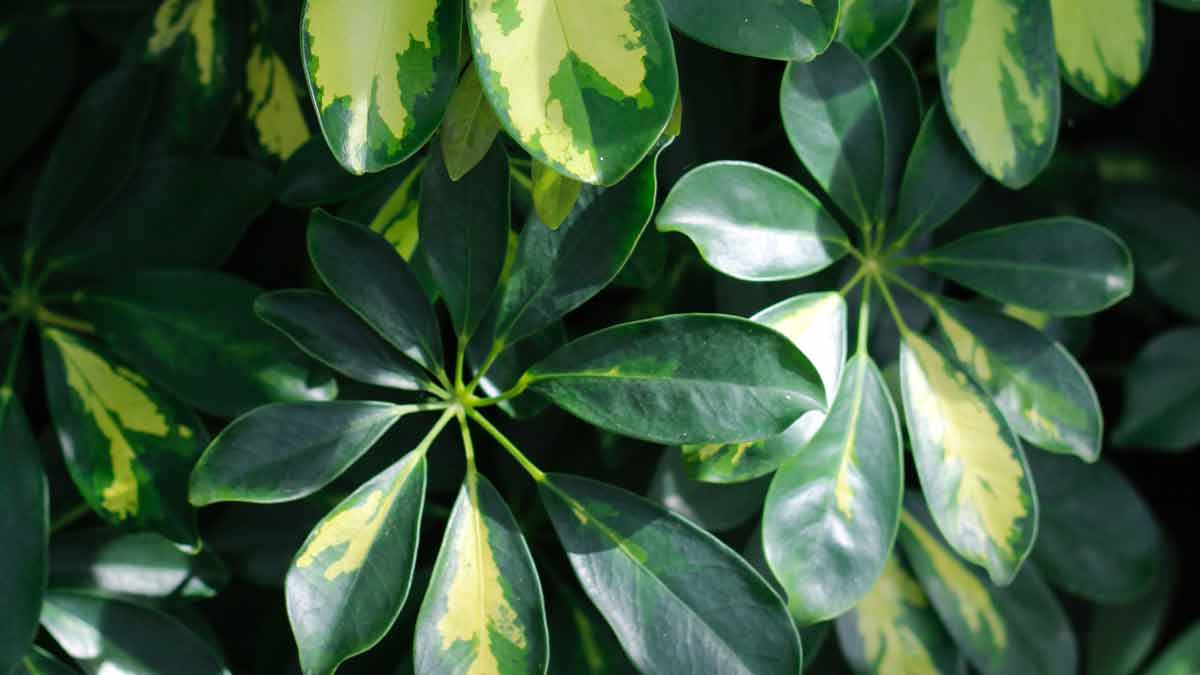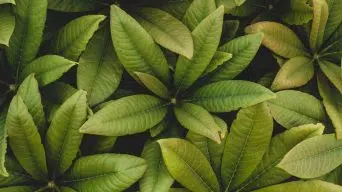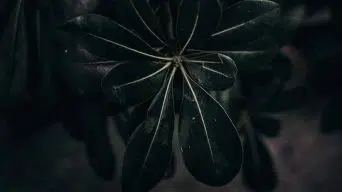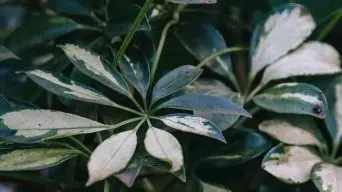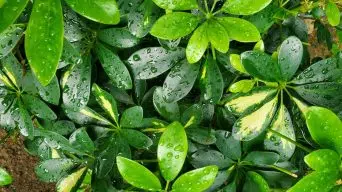Schefflera plants, also known as the Umbrella plant, are known for their tough, glossy leaves and their ability to tolerate neglect.
However, even the hardiest of plants can experience problems from time to time.
One common issue is drooping leaves.
There are several reasons why your Schefflera’s leaves might be drooping but don’t worry, most of them are easily remedied.
Here we’ll go over the most common causes of drooping leaves on Schefflera plants and how to fix them.
Why Are My Schefflera Leaves Drooping and How Can You Fix It?
There are several reasons why Schefflera leaves may droop and lose their luster.
If you notice your Schefflera leaves drooping, you must look closely at the plant and its environment to determine the cause.
Schefflera leaves may droop for several reasons, including:
1. Underwatering
The most common reason for Schefflera leaves to droop is underwatering.
A Schefflera must be watered about once a week or when the soil is dry.
If you notice the leaves drooping and wilting, it’s a sure sign that the plant is not getting enough water.
How To Tell If Your Schefflera Is Underwatered
There are a few telltale signs that your Schefflera is not getting enough water, including:
- The leaves are drooping
- The leaves are wilting
- The leaves are turning yellow
- The leaves are dry and crispy
- The soil is dry and crumbly
How To Fix An Underwatered Schefflera
To fix an underwatered Schefflera, water the plant deeply and evenly until water runs out of the drainage holes.
Allow the soil to dry out completely before watering again.
If the leaves are wilted or yellow, they will probably recover once the plant is properly hydrated.
Water your Schefflera once a week or when the soil is dry to the touch.
2. Overwatering
While underwatering is the most common reason Schefflera leaves droop, overwatering can also be a problem.
Schefflera plants are susceptible to root rot caused by too much water.
If the roots of the plant sit in water for too long, they will start to rot, and the plant will be unable to absorb moisture and nutrients.
This will cause the leaves to droop and eventually die.
How To Tell If Your Schefflera Is Overwatered
There are a few telltale signs that your Umbrella plant is getting too much water, including:
- The leaves are drooping
- The leaves are wilting
- The leaves are turning yellow, brown, or black
- The soil is soggy or mushy
- The soil is starting to mold
How To Fix An Overwatered Schefflera
If you think your Schefflera is overwatered, the first thing you need to do is stop watering it.
Let the soil dry out completely before watering again.
If the roots are already soggy, you may need to repot the Schefflera plant in fresh, dry soil.
You may need to trim off any already damaged leaves beyond repair.
Ensure you’re using a well-draining pot, and only water your Schefflera when the soil is dry.
3. Low Humidity
Schefflera plants come from tropical rainforests, so they prefer a humid environment.
If the air around your Schefflera is too dry, the leaves will start to droop and turn brown.
They require a relative humidity level of 50-70% to survive.
How To Tell If Your Schefflera Needs More Humidity
There are a few telltale signs that your Schefflera needs more humidity, including:
- The leaves are drooping
- The leaves are browning
- The leaves are dry and crispy
- -The tips of the leaves are brown or black
- The plant is wilting
How To Fix A Schefflera With Low Humidity
There are a few ways to increase the humidity around your Schefflera, including:
- Place the plant on a pebble tray. Fill a tray with pebbles and water, and place the Schefflera on top. The evaporating water will increase the humidity around the plant.
- Mist the leaves with water. This will help to increase the humidity around the plant, but it will only be temporary.
- Use a humidifier. This is the best way to increase the humidity around your Schefflera, but it can be expensive.
4. Heat Stress
Schefflera plants are tropical plants that prefer warm temperatures.
However, they can’t tolerate extreme heat or direct sunlight.
If the leaves of your Schefflera are drooping and turning brown, it’s probably because the plant is too hot.
Umbrella plants should be kept in a room with temperatures between 65-80 degrees Fahrenheit.
They should also be kept out of direct sunlight.
How To Tell If Your Schefflera Is Stressed From Heat
There are a few telltale signs that your Schefflera is stressed from heat, including:
- The leaves are drooping
- The leaves are wilting
- -The leaves are turning brown or black
- The leaves are dry and crispy
- The plant is wilting
How To Fix A Schefflera Stressed From Heat
If you think your Schefflera is stressed from heat, you first need to move it to a cooler location.
Ensure the temperature around the plant is between 65-80 degrees Fahrenheit.
You should also make sure the Schefflera plant is out of direct sunlight.
If the leaves are already damaged, you may need to trim them off.
5. Not Enough Sunlight
Schefflera plants need bright indirect light to thrive.
The leaves will droop and turn yellow if they don’t get enough light.
The umbrella plant may also begin to stretch out and become leggy.
Umbrella plants should be kept where they will receive bright indirect sunlight.
They should not be kept in direct sunlight, as this will scorch the leaves.
How To Tell If Your Schefflera Isn’t Getting Enough Sunlight
There are a few telltale signs that your Schefflera isn’t getting enough sunlight, including:
- The leaves are drooping
- The leaves are turning yellow
- The plant is stretching out and becoming leggy
- The plant is not producing new leaves
How To Fix A Schefflera That Isn’t Getting Enough Sunlight
If you think your Schefflera isn’t getting enough sunlight, you first need to move it to a brighter location.
Ensure the plant is in a place where it will receive bright indirect sunlight.
An east- or west-facing window is ideal.
You should also ensure the Schefflera plant is not in direct sunlight, which will scorch the leaves.
6. Transplant Shock
Transplant shock is a common problem when plants are moved to a new location.
When Scheffleras are transplanted, they undergo a period of adjustment where the roots are used to the new soil.
During this time, the Schefflera may lose some leaves, and the leaves may droop.
The Schefflera will eventually recover from transplant shock, which may take a few weeks.
How To Tell If Your Schefflera Is In Transplant Shock
There are a few telltale signs that your Schefflera is in transplant shock, including:
- The leaves droop and turn yellow or brown
- The stems are limp and may even fall over
- The plant stops growing
- The plant looks wilted
How To Fix A Schefflera In Transplant Shock
If you think your Schefflera is in transplant shock, the best thing you can do is give it time to recover.
Ensure the plant is in a location where it will receive bright indirect sunlight.
Water the plant when the soil is dry to the touch.
Do not fertilize the plant during this time.
The Schefflera will eventually recover from transplant shock and start to grow new leaves.
7. Pest Infestation
Pests can also cause Schefflera leaves to droop.
The most common pests that affect Scheffleras are scale, mealybugs, and spider mites.
These pests suck the sap out of the leaves, which can cause yellow leaves and drooping.
Pest infestations can also cause the plant to stop growing.
How To Tell If Your Schefflera Has A Pest Infestation
There are a few telltale signs that your Schefflera has a pest infestation, including:
- The leaves are drooping
- The leaves are turning yellow or brown
- You see pests on the plant
- The leaves have a sticky substance on them
- The plant is covered in webbing
How To Fix A Schefflera With A Pest Infestation
If you think your Schefflera has a pest infestation, the best thing you can do is treat it with insecticidal soap or neem oil. These products are safe to use on Scheffleras and kill pests without harming the plant.
You need to make sure you treat the plant every few days until the pests are gone.
You should also quarantine the plant from other plants to prevent the pests from spreading.
If the infestation is not too bad, you can try to remove the pests by hand.
Use a cotton swab or a Q-tip dipped in alcohol to remove the pests from the plant.
How To Prevent Schefflera Leaves From Drooping?
If your Schefflera leaves are drooping, it could be due to several reasons.
Thankfully, you can do a few things to prevent this from happening.
- Schefflera plants prefer bright, indirect light. If you notice your Umbrella plant drooping, it could be because it’s not getting enough light.
- Schefflera plants like to be moist but not wet. Ensure you’re regularly watering your plant and allowing the soil to dry out slightly between waterings.
- Schefflera plants need well-draining soil. Be sure to use a pot with drainage holes and a light, airy potting soil mix.
- Schefflera plants are susceptible to mealybugs and other pests. Inspect your plant regularly and treat it accordingly if you see any pests.
- Schefflera plants can also be susceptible to root rot. Ensure the pot has drainage holes, and don’t water your plant too often.
- Schefflera plants need to be fed regularly. Use a balanced fertilizer every two weeks during the growing season and monthly during the winter.
- Schefflera plants can be sensitive to temperature changes. Avoid drafts and sudden temperature changes to prevent your Schefflera leaves from drooping.
Following these tips can help prevent your Schefflera leaves from drooping.
Final Thoughts
There are several reasons why Schefflera leaves may droop.
The most common reason is that the plant is not getting enough water.
Other reasons include transplant shock, pests, and lack of light.
If you notice your Schefflera leaves drooping, the best thing you can do is try to figure out the cause.
Once you know the cause, you can take steps to fix the problem and prevent it from happening again in the future.

